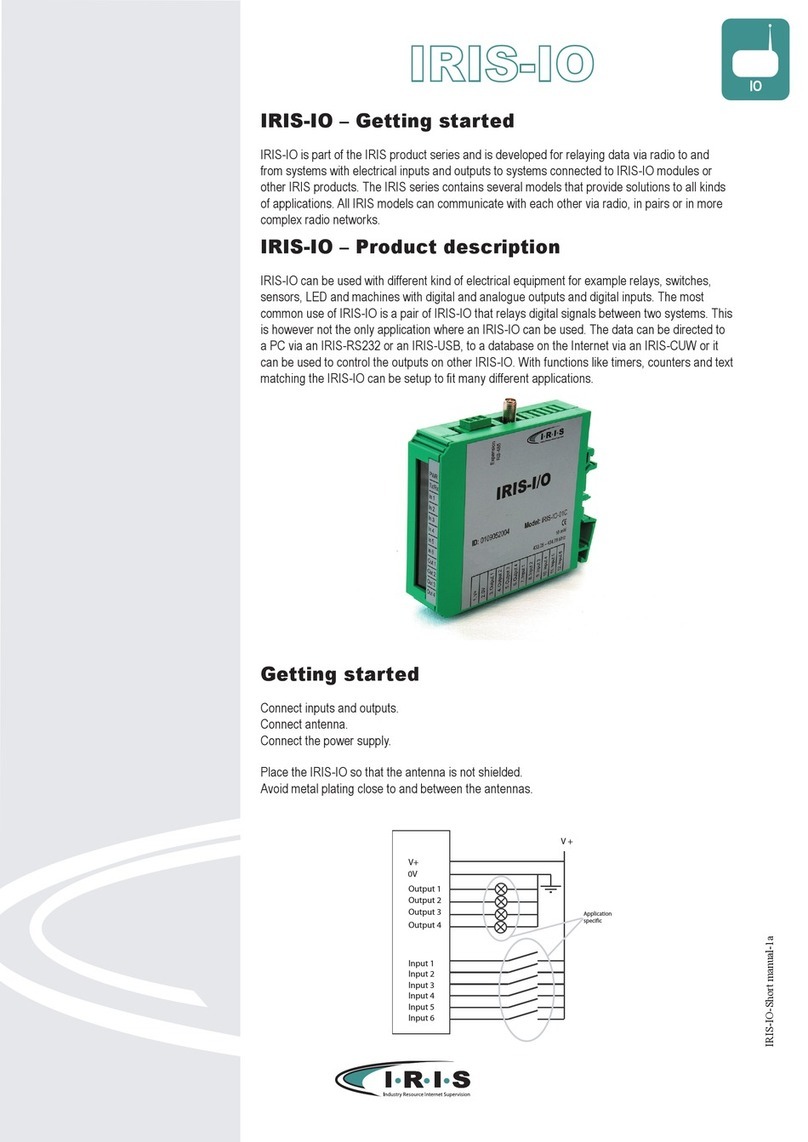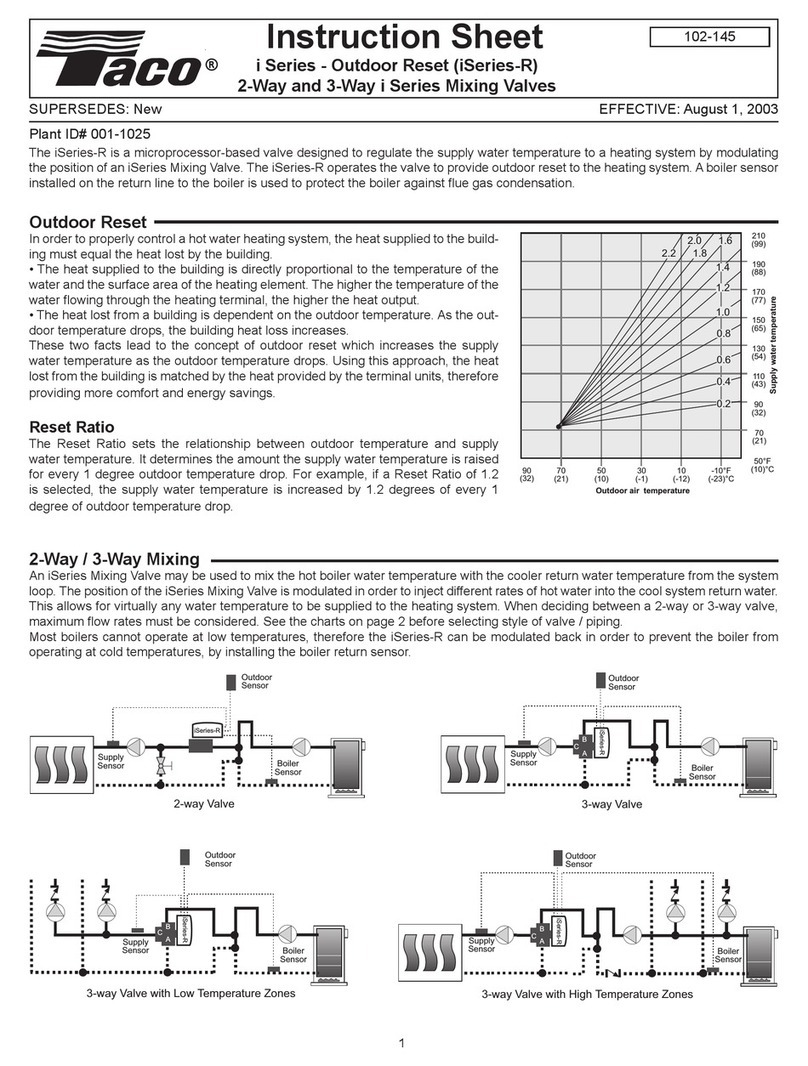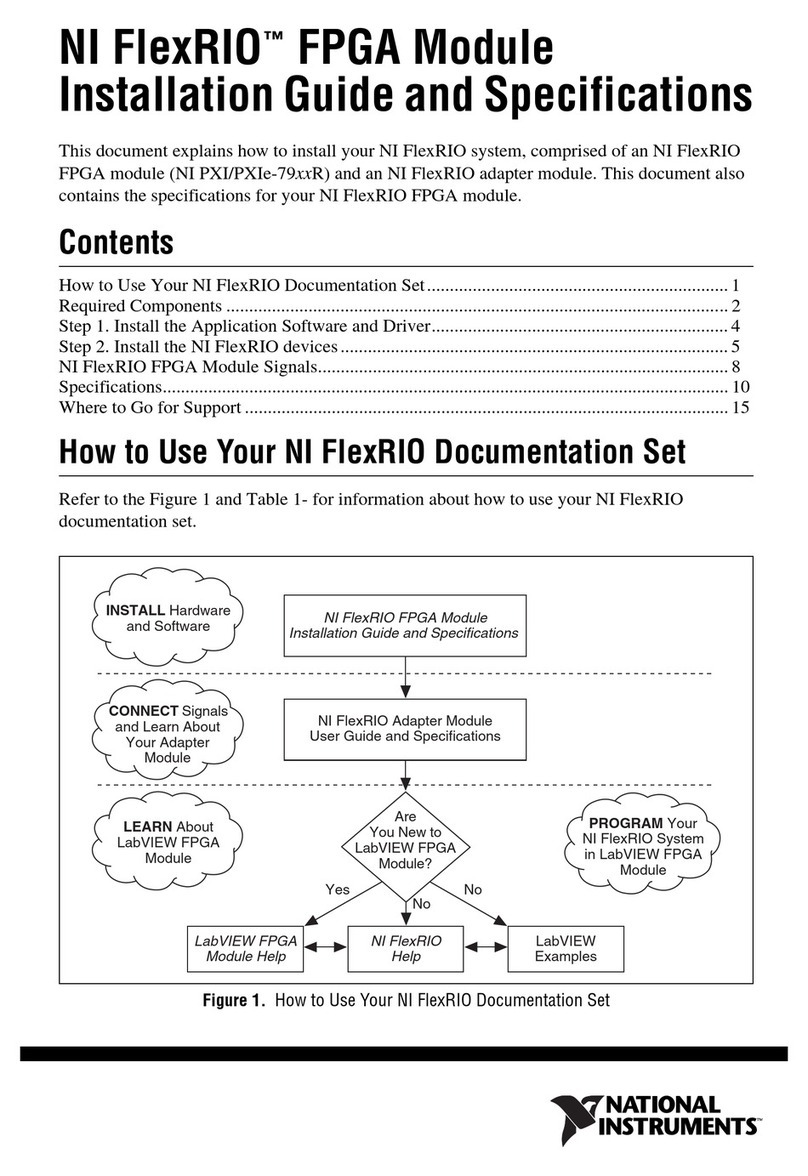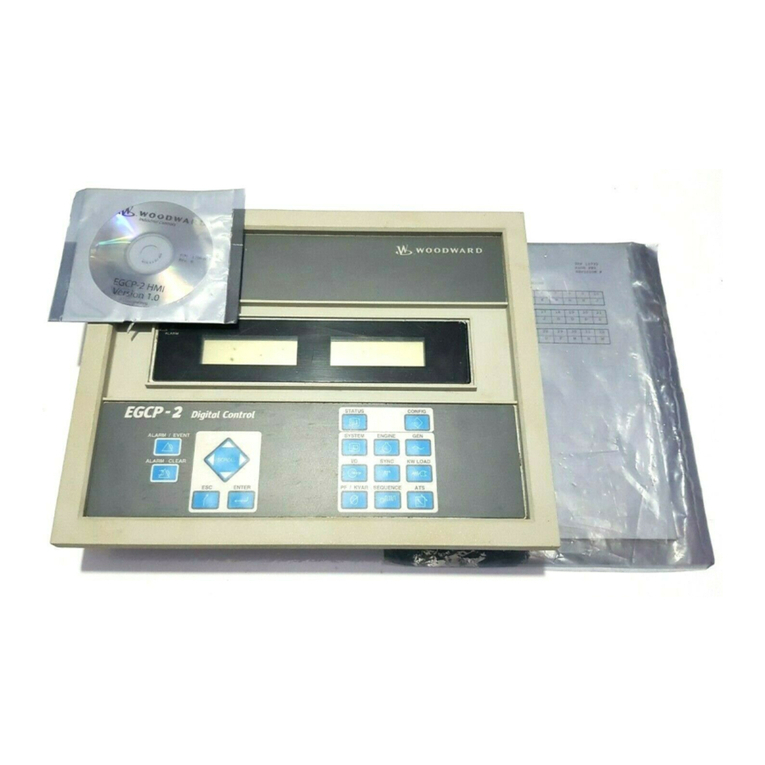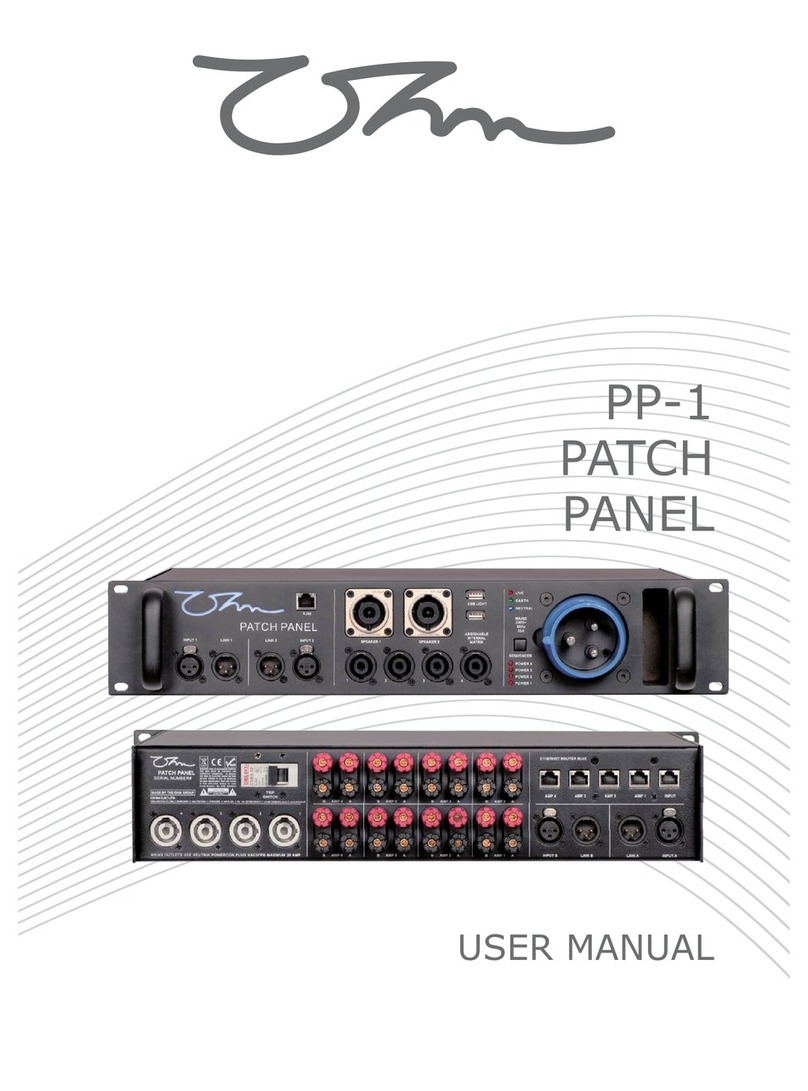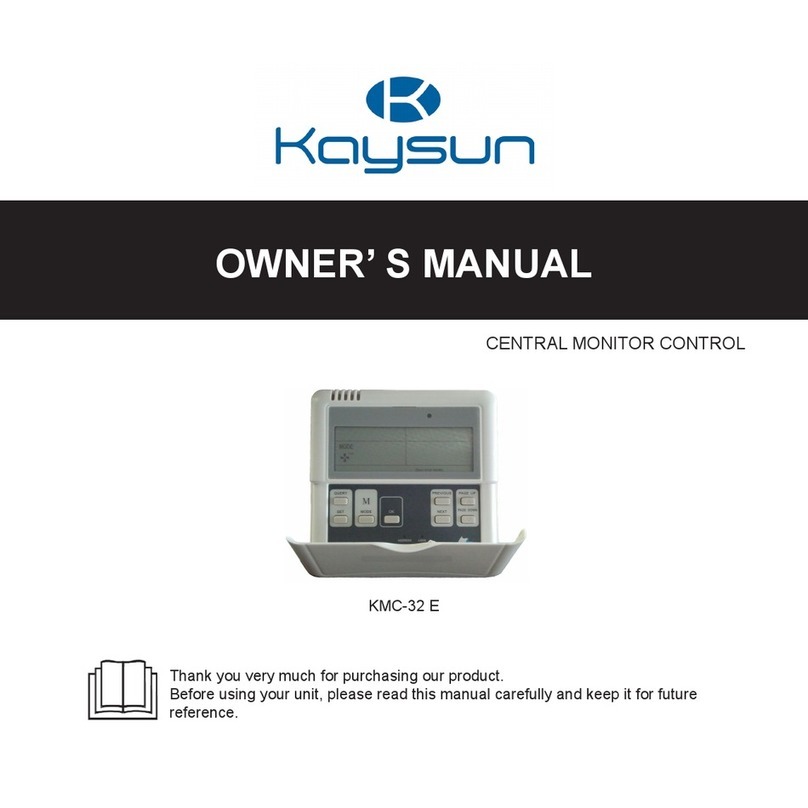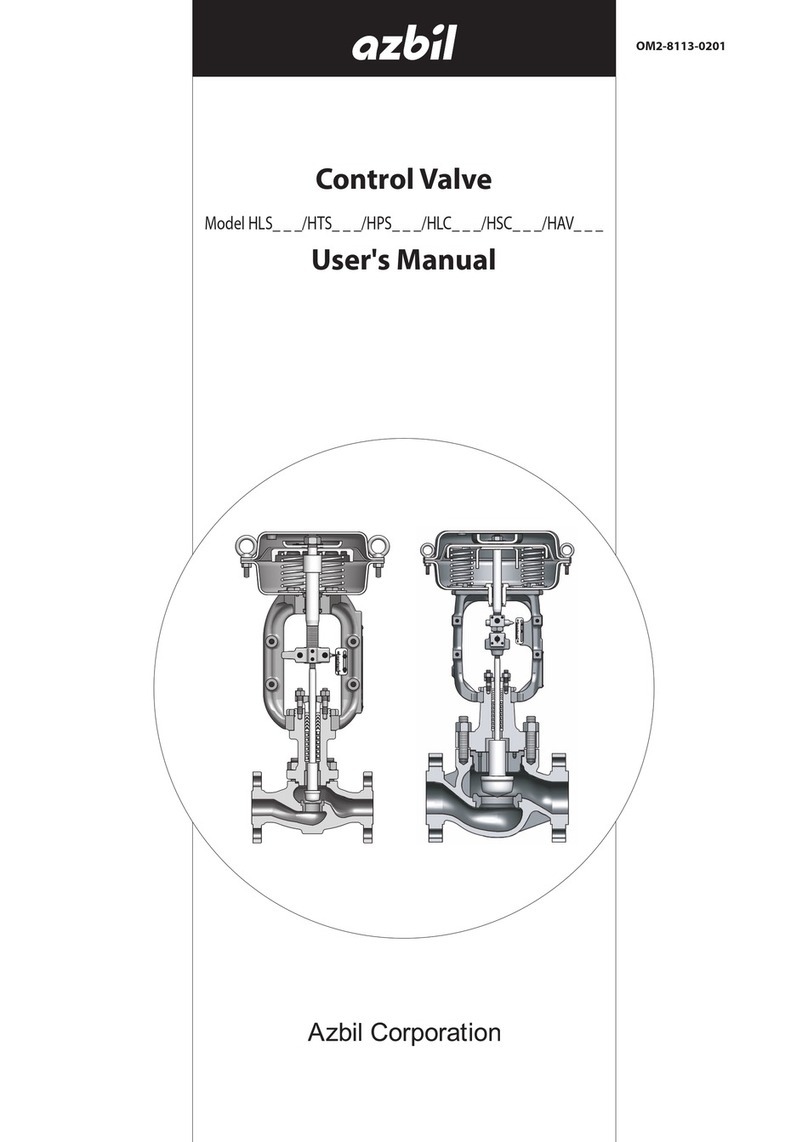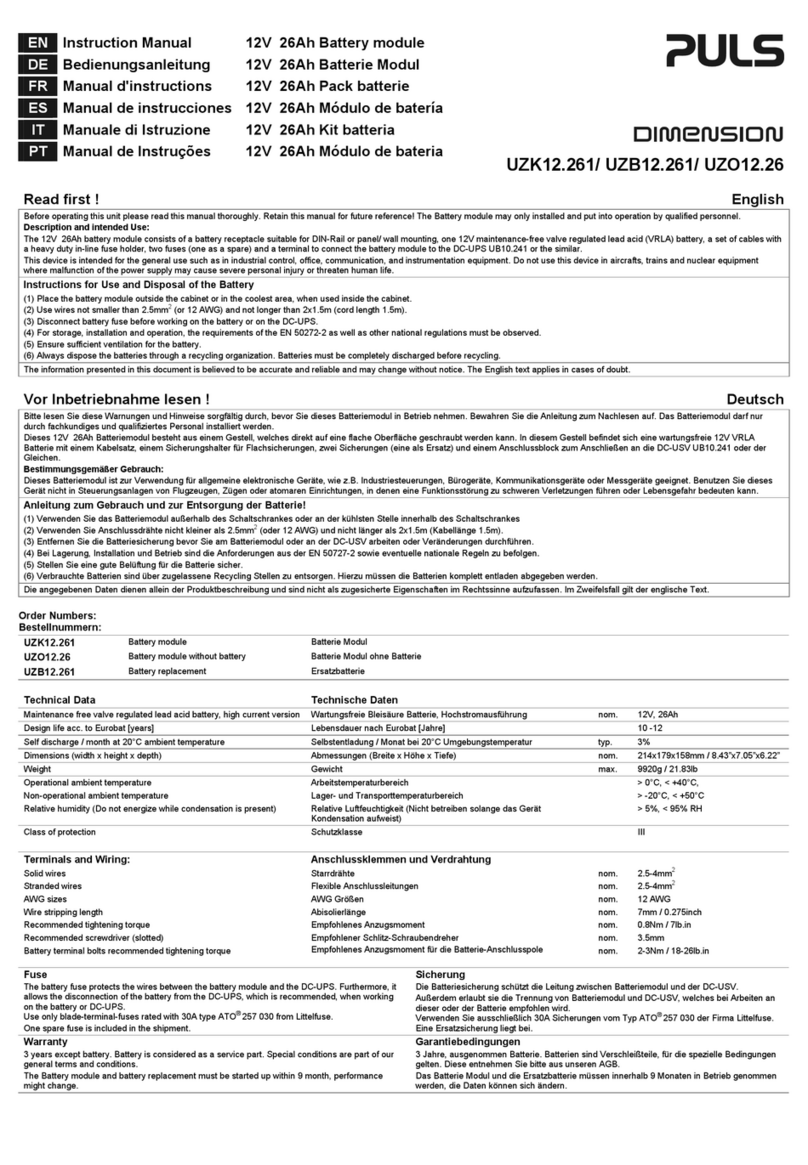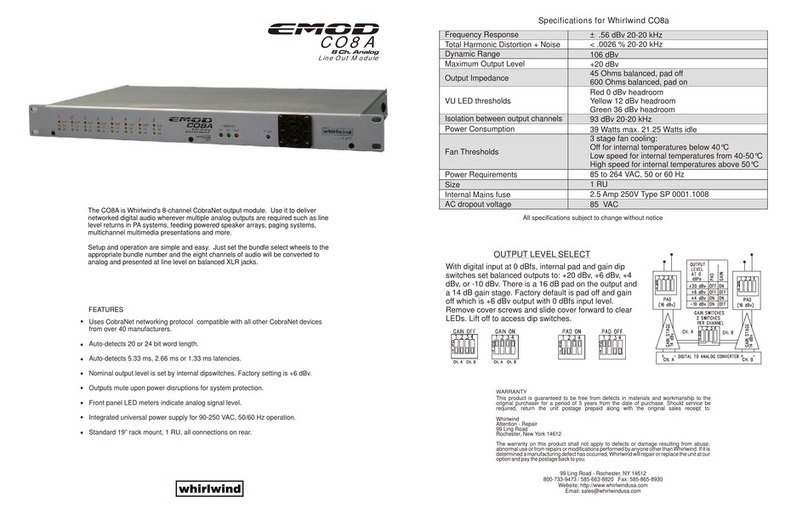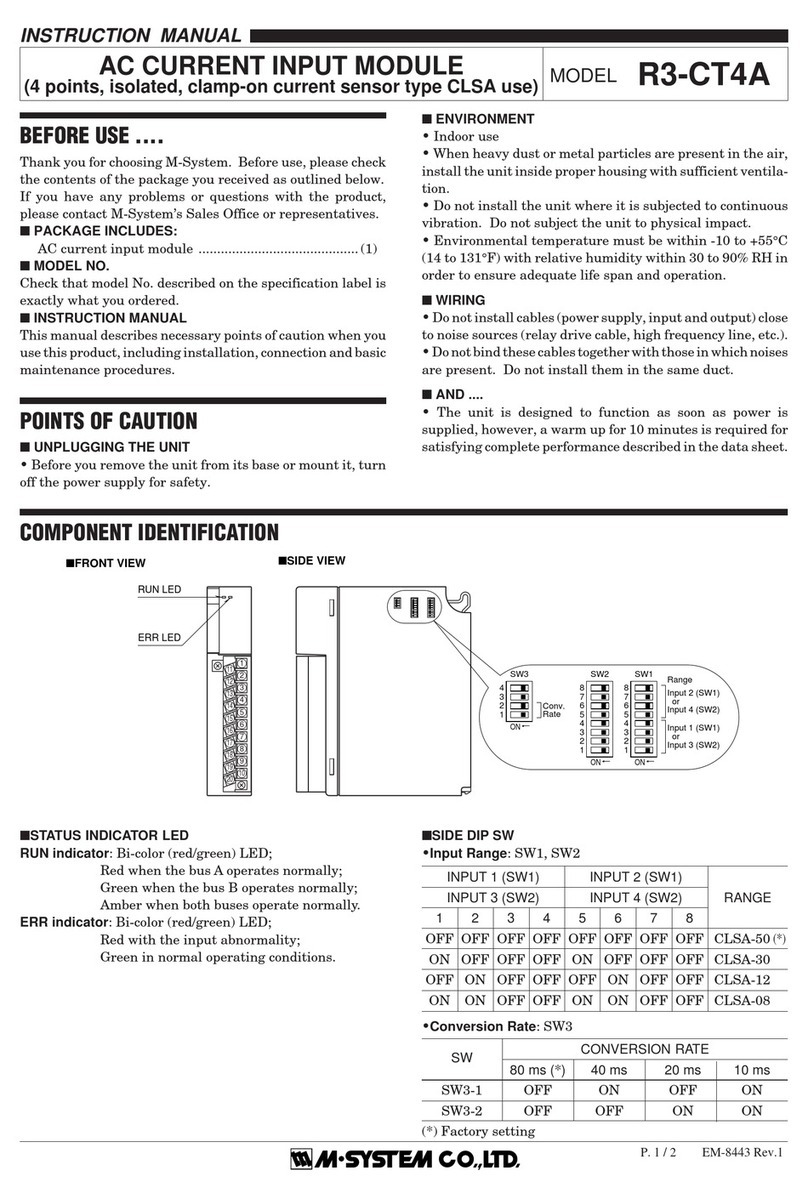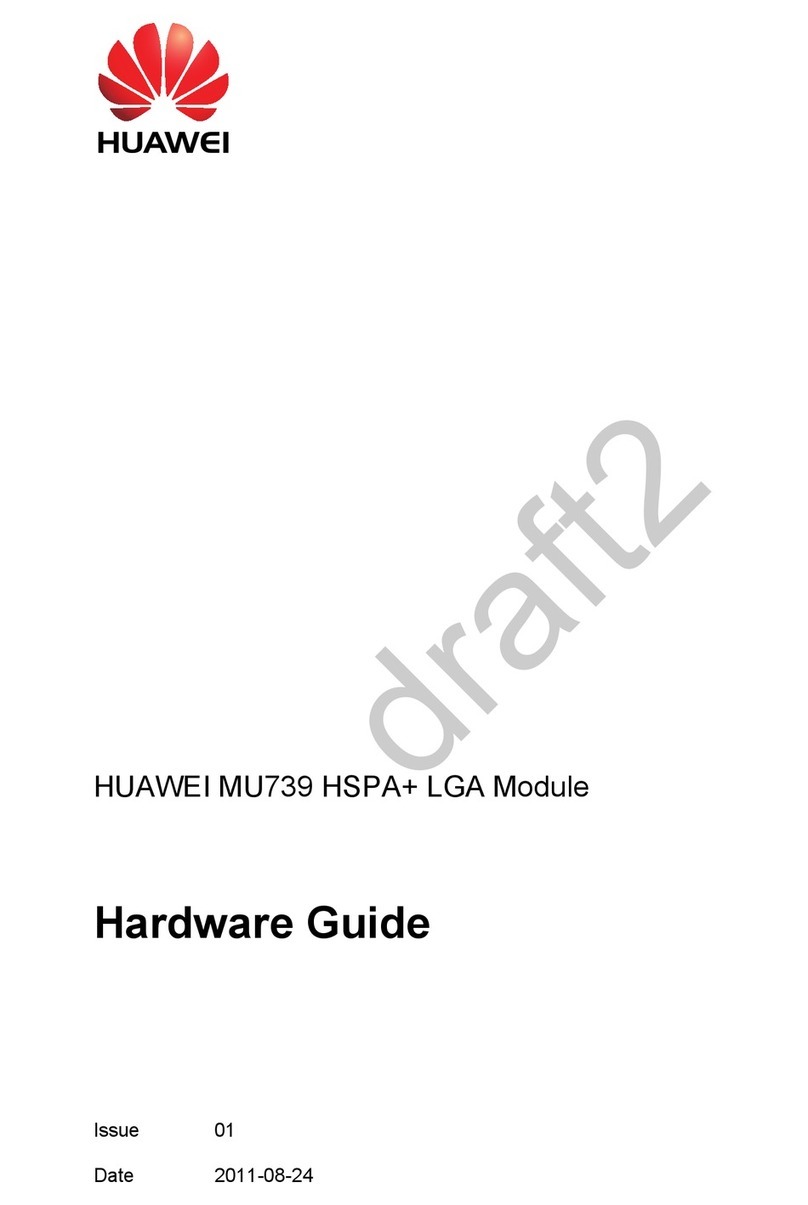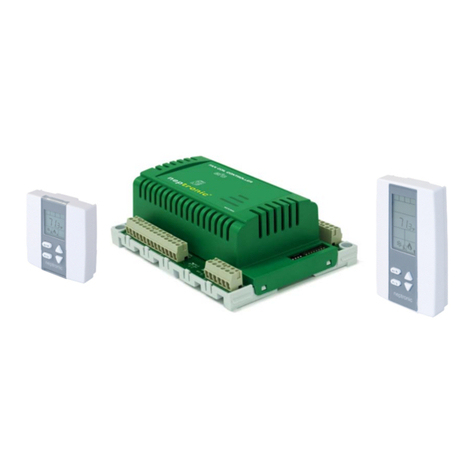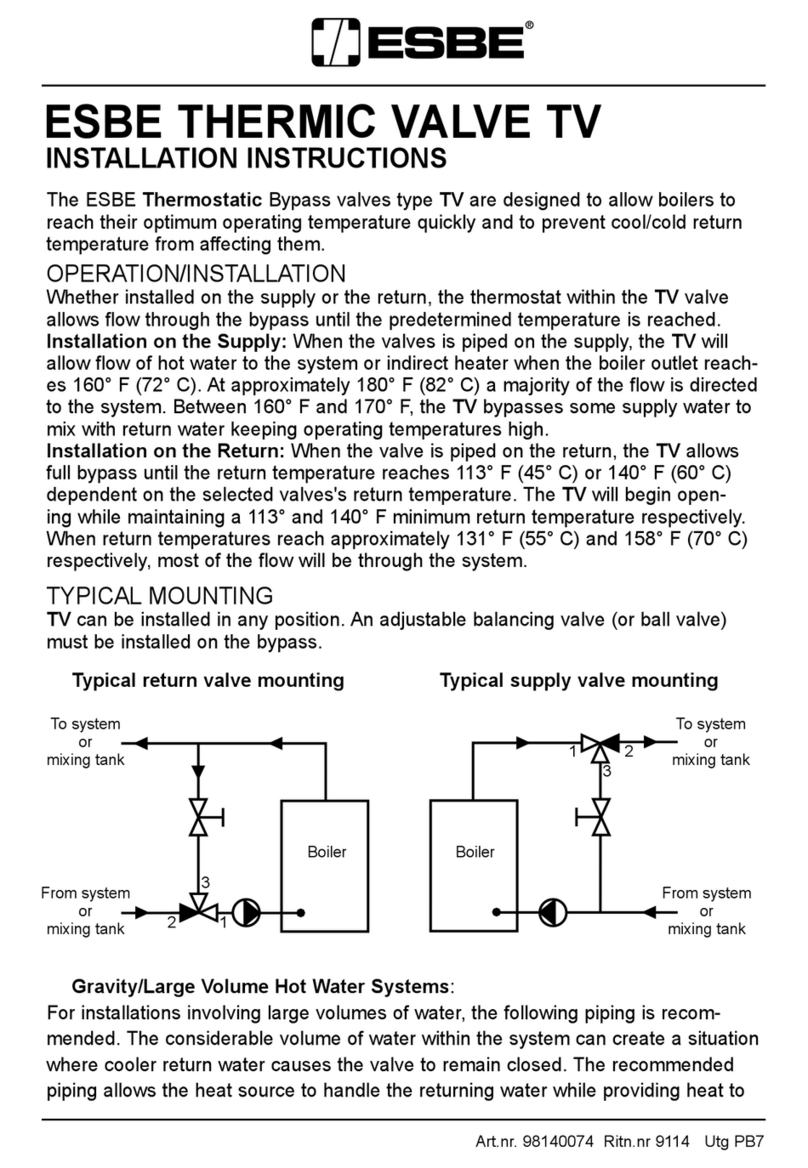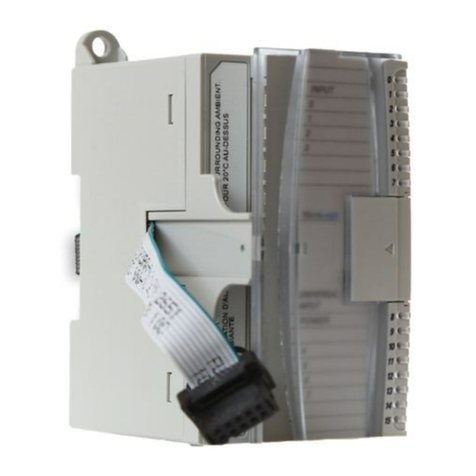GE Digital Energy L60 User manual

GE
Digital Energy
Instruction Manual
Product version: 7.3x
GE publication code: 1601-0082-AB2 (GEK-119622A)
L60
Line Phase Comparison System
1601-0082-AB2
IISO 9001
G
N
E
I
L
M
I
U
T
L
T
E
S
I
R
G
E
E
D
R
LISTED
52TL
IND.CONT. EQ.
E83849

Copyright © 2015 GE Multilin Inc. All rights reserved.
L60 Line Phase Comparison System Instruction Manual for version 7.3x.
L60, FlexLogic, FlexElement, FlexCurve, FlexAnalog, FlexInteger, FlexState, EnerVista,
CyberSentry, HardFiber, Digital Energy, Multilin, and GE Multilin are trademarks or
registered trademarks of GE Multilin Inc.
The contents of this manual are the property of GE Multilin Inc. This documentation is
furnished on license and may not be reproduced in whole or in part without the permission
of GE Multilin. The content of this manual is for informational use only and is subject to
change without notice.
Part number: 1601-0082-AB2 (September 2015)

L60 LINE PHASE COMPARISON SYSTEM – INSTRUCTION MANUAL iii
L60 Line Phase Comparison System
Table of contents
1 INTRODUCTION 1.1 Safety symbols and definitions...................................................................... 1-1
1.1.1 General cautions and warnings...................................................................................... 1-1
1.2 For further assistance ..................................................................................... 1-2
2PRODUCT
DESCRIPTION
2.1 Product description.......................................................................................... 2-1
2.2 Security .............................................................................................................. 2-4
2.3 Order codes ....................................................................................................... 2-8
2.3.1 Replacement modules.......................................................................................................2-11
2.4 Signal processing ...........................................................................................2-13
2.4.1 UR signal processing ..........................................................................................................2-13
2.5 Specifications..................................................................................................2-15
2.5.1 Protection elements............................................................................................................2-15
2.5.2 User-programmable elements ......................................................................................2-22
2.5.3 Monitoring................................................................................................................................2-24
2.5.4 Metering....................................................................................................................................2-24
2.5.5 Inputs .........................................................................................................................................2-25
2.5.6 Power supply..........................................................................................................................2-27
2.5.7 Outputs .....................................................................................................................................2-27
2.5.8 Communication protocols ...............................................................................................2-29
2.5.9 Inter-relay communications ...........................................................................................2-30
2.5.10 Environmental........................................................................................................................2-32
2.5.11 Type tests.................................................................................................................................2-33
2.5.12 Production tests....................................................................................................................2-33
2.5.13 Approvals .................................................................................................................................2-34
2.5.14 Maintenance...........................................................................................................................2-34
3 INSTALLATION 3.1 Unpack and inspect ......................................................................................... 3-1
3.2 Panel cutouts .................................................................................................... 3-2
3.2.1 Horizontal units....................................................................................................................... 3-2
3.2.2 Vertical units............................................................................................................................. 3-3
3.2.3 Rear terminal layout ............................................................................................................. 3-8
3.3 Wiring ................................................................................................................. 3-9
3.3.1 Typical wiring ........................................................................................................................... 3-9
3.3.2 Dielectric strength.................................................................................................................. 3-9

iv L60 LINE PHASE COMPARISON SYSTEM – INSTRUCTION MANUAL
TABLE OF CONTENTS
3.3.3 Control power........................................................................................................................3-10
3.3.4 CT/VT modules ......................................................................................................................3-11
3.3.5 Contact inputs and outputs...........................................................................................3-12
3.3.6 Transducer inputs and outputs.....................................................................................3-19
3.3.7 RS232 faceplate port..........................................................................................................3-21
3.3.8 CPU communication ports ..............................................................................................3-21
3.3.9 IRIG-B.........................................................................................................................................3-23
3.3.10 L60 channel communications .......................................................................................3-24
3.4 Direct input and output communications .................................................3-26
3.4.1 Description..............................................................................................................................3-26
3.4.2 Fiber: LED and ELED transmitters.................................................................................3-28
3.4.3 Fiber laser transmitters.....................................................................................................3-28
3.4.4 G.703 interface......................................................................................................................3-29
3.4.5 RS422 interface.....................................................................................................................3-33
3.4.6 RS422 and fiber interface ................................................................................................3-35
3.4.7 G.703 and fiber interface .................................................................................................3-35
3.4.8 IEEE C37.94 interface .........................................................................................................3-36
3.4.9 C37.94SM interface.............................................................................................................3-39
3.5 Activate relay ..................................................................................................3-42
3.6 Install software...............................................................................................3-43
3.6.1 EnerVista communication overview ...........................................................................3-43
3.6.2 System requirements.........................................................................................................3-44
3.6.3 Install software .....................................................................................................................3-44
3.7 Configure the L60 for software access.......................................................3-45
3.7.1 Configure serial communication..................................................................................3-46
3.7.2 Configure Ethernet communication ...........................................................................3-47
3.7.3 Automatic discovery of UR devices.............................................................................3-48
3.8 Connect to the L60 .........................................................................................3-48
3.8.1 Connect to the L60 in EnerVista....................................................................................3-48
3.8.2 Use Quick Connect via the front panel RS232 port .............................................3-49
3.8.3 Use Quick Connect via a rear Ethernet port............................................................3-50
3.9 Set up CyberSentry and change default password..................................3-55
4 INTERFACES 4.1 EnerVista software interface..........................................................................4-1
4.1.1 Introduction...............................................................................................................................4-1
4.1.2 Settings files ..............................................................................................................................4-1
4.1.3 Event viewing............................................................................................................................4-2
4.1.4 File support ................................................................................................................................4-2
4.1.5 EnerVista main window .......................................................................................................4-2
4.1.6 Settings templates .................................................................................................................4-3
4.1.7 Secure and lock FlexLogic equations............................................................................4-8
4.1.8 Settings file traceability.....................................................................................................4-10
4.2 Front panel interface .....................................................................................4-12
4.2.1 Front panel display..............................................................................................................4-12
4.2.2 Front panel keypad.............................................................................................................4-12
4.2.3 Menu navigation ..................................................................................................................4-13
4.2.4 Menu hierarchy.....................................................................................................................4-13
4.2.5 Changing settings................................................................................................................4-14
4.2.6 Faceplate.................................................................................................................................4-15
4.2.7 LED indicators........................................................................................................................4-17
4.2.8 Custom LED labeling ..........................................................................................................4-20
4.2.9 Breaker control .....................................................................................................................4-25
4.2.10 Change passwords .............................................................................................................4-26
4.2.11 Invalid password entry......................................................................................................4-27

TABLE OF CONTENTS
L60 LINE PHASE COMPARISON SYSTEM – INSTRUCTION MANUAL v
4.3 Logic diagrams ...............................................................................................4-28
5 SETTINGS 5.1 Settings menu ................................................................................................... 5-1
5.2 Overview ............................................................................................................ 5-4
5.2.1 Introduction to elements .................................................................................................... 5-4
5.2.2 Introduction to AC sources ................................................................................................ 5-5
5.3 Product setup.................................................................................................... 5-7
5.3.1 Security ....................................................................................................................................... 5-7
5.3.2 Display properties ................................................................................................................5-25
5.3.3 Clear relay records ..............................................................................................................5-27
5.3.4 Communications ..................................................................................................................5-28
5.3.5 Modbus user map ................................................................................................................5-81
5.3.6 Real-time clock......................................................................................................................5-82
5.3.7 Fault reports ...........................................................................................................................5-86
5.3.8 Oscillography .........................................................................................................................5-88
5.3.9 Data logger .............................................................................................................................5-90
5.3.10 User-programmable LEDs ...............................................................................................5-91
5.3.11 User-programmable self-tests ......................................................................................5-95
5.3.12 Control pushbuttons...........................................................................................................5-95
5.3.13 User-programmable pushbuttons...............................................................................5-97
5.3.14 Flex state parameters.....................................................................................................5-102
5.3.15 User-definable displays..................................................................................................5-103
5.3.16 Direct inputs and outputs..............................................................................................5-105
5.3.17 Teleprotection.....................................................................................................................5-112
5.3.18 Installation............................................................................................................................5-113
5.4 System setup.................................................................................................5-113
5.4.1 AC inputs ...............................................................................................................................5-113
5.4.2 Power system......................................................................................................................5-115
5.4.3 Signal sources.....................................................................................................................5-115
5.4.4 Breakers.................................................................................................................................5-118
5.4.5 Disconnect switches........................................................................................................5-123
5.4.6 FlexCurves ............................................................................................................................5-126
5.5 FlexLogic ........................................................................................................5-133
5.5.1 FlexLogic operands ..........................................................................................................5-133
5.5.2 FlexLogic rules ....................................................................................................................5-146
5.5.3 FlexLogic evaluation ........................................................................................................5-146
5.5.4 FlexLogic example............................................................................................................5-147
5.5.5 FlexLogic equation editor..............................................................................................5-152
5.5.6 FlexLogic timers .................................................................................................................5-152
5.5.7 FlexElements .......................................................................................................................5-152
5.5.8 Non-volatile latches .........................................................................................................5-156
5.6 Grouped elements........................................................................................5-157
5.6.1 Overview................................................................................................................................5-157
5.6.2 Setting group 1...................................................................................................................5-157
5.6.3 Phase comparison elements .......................................................................................5-158
5.6.4 Line pickup ...........................................................................................................................5-176
5.6.5 Distance.................................................................................................................................5-178
5.6.6 Power swing detect (ANSI 68)......................................................................................5-197
5.6.7 Load encroachment ........................................................................................................5-206
5.6.8 Phase current......................................................................................................................5-207
5.6.9 Neutral current...................................................................................................................5-219
5.6.10 Wattmetric ground fault................................................................................................5-227
5.6.11 Ground current...................................................................................................................5-231
5.6.12 Negative sequence current..........................................................................................5-234
5.6.13 Breaker failure (ANSI 50BF) ...........................................................................................5-240

vi L60 LINE PHASE COMPARISON SYSTEM – INSTRUCTION MANUAL
TABLE OF CONTENTS
5.6.14 Voltage elements .............................................................................................................. 5-249
5.7 Control elements ..........................................................................................5-256
5.7.1 Overview ............................................................................................................................... 5-256
5.7.2 Trip bus .................................................................................................................................. 5-256
5.7.3 Setting groups .................................................................................................................... 5-258
5.7.4 Selector switch................................................................................................................... 5-259
5.7.5 Trip output............................................................................................................................ 5-265
5.7.6 Synchrocheck (ANSI 25) ................................................................................................. 5-271
5.7.7 Digital elements................................................................................................................. 5-274
5.7.8 Digital counters.................................................................................................................. 5-277
5.7.9 Monitoring elements ....................................................................................................... 5-279
5.7.10 Pilot schemes...................................................................................................................... 5-296
5.7.11 Autoreclose (ANSI 79)...................................................................................................... 5-299
5.8 Inputs/outputs ..............................................................................................5-313
5.8.1 Contact inputs.................................................................................................................... 5-313
5.8.2 Virtual inputs....................................................................................................................... 5-315
5.8.3 Contact outputs................................................................................................................. 5-316
5.8.4 Virtual outputs.................................................................................................................... 5-318
5.8.5 Resetting ............................................................................................................................... 5-319
5.8.6 Direct inputs and outputs ............................................................................................. 5-319
5.8.7 Teleprotection..................................................................................................................... 5-323
5.9 Transducer inputs/outputs.........................................................................5-325
5.9.1 DCmA inputs ....................................................................................................................... 5-325
5.9.2 RTD inputs ............................................................................................................................ 5-326
5.9.3 DCmA outputs .................................................................................................................... 5-327
5.10 Testing............................................................................................................5-330
5.10.1 Test mode function .......................................................................................................... 5-330
5.10.2 Test mode forcing............................................................................................................. 5-331
5.10.3 Force contact inputs ....................................................................................................... 5-332
5.10.4 Force contact outputs .................................................................................................... 5-332
6 ACTUAL VALUES 6.1 Actual values menu..........................................................................................6-1
6.2 Status..................................................................................................................6-3
6.2.1 Contact inputs..........................................................................................................................6-3
6.2.2 Virtual inputs.............................................................................................................................6-3
6.2.3 RxGOOSE boolean inputs ....................................................................................................6-3
6.2.4 RxGOOSE DPS inputs.............................................................................................................6-4
6.2.5 Teleprotection inputs ............................................................................................................6-4
6.2.6 Contact outputs.......................................................................................................................6-4
6.2.7 Virtual outputs..........................................................................................................................6-5
6.2.8 RxGOOSE status.......................................................................................................................6-5
6.2.9 RxGOOSE statistics.................................................................................................................6-5
6.2.10 Autoreclose................................................................................................................................6-6
6.2.11 Digital counters........................................................................................................................6-6
6.2.12 Selector switches ....................................................................................................................6-6
6.2.13 Flex States ..................................................................................................................................6-6
6.2.14 Ethernet.......................................................................................................................................6-7
6.2.15 Real time clock synchronizing ..........................................................................................6-7
6.2.16 Direct inputs ..............................................................................................................................6-8
6.2.17 Direct devices status.............................................................................................................6-8
6.2.18 Teleprotection channel tests.............................................................................................6-8
6.2.19 Remaining connection status ...........................................................................................6-9
6.2.20 Parallel Redundancy Protocol (PRP) ...............................................................................6-9
6.3 Metering...........................................................................................................6-10
6.3.1 Metering conventions........................................................................................................6-10

TABLE OF CONTENTS
L60 LINE PHASE COMPARISON SYSTEM – INSTRUCTION MANUAL vii
6.3.2 Sources......................................................................................................................................6-14
6.3.3 Synchrocheck.........................................................................................................................6-17
6.3.4 Tracking frequency..............................................................................................................6-17
6.3.5 FlexElements ..........................................................................................................................6-18
6.3.6 RxGOOSE analogs................................................................................................................6-18
6.3.7 Wattmetric ground fault...................................................................................................6-19
6.3.8 Transducer inputs/outputs..............................................................................................6-19
6.3.9 Distance....................................................................................................................................6-19
6.4 Records.............................................................................................................6-21
6.4.1 Fault reports ...........................................................................................................................6-21
6.4.2 Event records .........................................................................................................................6-21
6.4.3 Oscillography .........................................................................................................................6-22
6.4.4 Data logger .............................................................................................................................6-22
6.4.5 Breaker maintenance.........................................................................................................6-22
6.5 Product information ......................................................................................6-23
6.5.1 Model information................................................................................................................6-23
6.5.2 Firmware revisions ..............................................................................................................6-23
7 COMMANDS AND
TARGETS
7.1 Commands menu ............................................................................................. 7-1
7.1.1 Virtual inputs ............................................................................................................................ 7-2
7.1.2 Clear records ............................................................................................................................ 7-2
7.1.3 Set date and time................................................................................................................... 7-3
7.1.4 Relay maintenance................................................................................................................ 7-3
7.1.5 Security ....................................................................................................................................... 7-4
7.2 Targets menu .................................................................................................... 7-4
7.2.1 Target messages.................................................................................................................... 7-5
7.2.2 Relay self-tests ........................................................................................................................ 7-5
8 APPLICATION OF
SETTINGS
8.1 87PC phase comparison element.................................................................. 8-1
8.1.1 Overview..................................................................................................................................... 8-1
8.1.2 Settings ....................................................................................................................................... 8-1
8.1.3 Settings example.................................................................................................................... 8-3
8.2 Distance/backup supervision ........................................................................ 8-4
8.2.1 Overview..................................................................................................................................... 8-4
8.2.2 Lines with tapped transformers...................................................................................... 8-5
8.2.3 Transformer load currents................................................................................................. 8-6
8.2.4 Low-voltage-side faults....................................................................................................... 8-6
8.2.5 Transformer inrush current............................................................................................... 8-6
8.2.6 Tractional load......................................................................................................................... 8-7
8.2.7 Sensitivity issues..................................................................................................................... 8-7
8.2.8 Single-pole tripping applications .................................................................................... 8-9
8.2.9 Phase distance ......................................................................................................................8-10
8.2.10 Ground distance ...................................................................................................................8-11
8.3 POTT signaling scheme .................................................................................8-11
8.3.1 Overview...................................................................................................................................8-11
8.4 Series compensated lines .............................................................................8-12
8.4.1 Distance settings..................................................................................................................8-12
8.5 Understanding L60 oscillography ...............................................................8-14
8.5.1 Overview...................................................................................................................................8-14
8.5.2 Two-breaker configuration..............................................................................................8-15
9 THEORY OF
OPERATION
9.1 Overview ............................................................................................................ 9-1
9.1.1 Introduction .............................................................................................................................. 9-1

viii L60 LINE PHASE COMPARISON SYSTEM – INSTRUCTION MANUAL
TABLE OF CONTENTS
9.1.2 Fundamental principle of phase comparison ...........................................................9-1
9.1.3 Variations in phase comparison schemes..................................................................9-7
9.1.4 Phase comparison excitation............................................................................................9-7
9.1.5 Blocking versus tripping schemes ...............................................................................9-12
9.1.6 Single versus dual phase comparison.......................................................................9-19
9.1.7 Refinements to basic schemes .....................................................................................9-21
9.1.8 Multi-terminal lines .............................................................................................................9-24
9.1.9 Charging current compensation ..................................................................................9-25
9.1.10 L60 signal processing ........................................................................................................9-27
9.2 Single-pole tripping........................................................................................9-34
9.2.1 Overview ..................................................................................................................................9-34
9.2.2 Phase selection.....................................................................................................................9-37
9.3 Fault locator ....................................................................................................9-39
9.3.1 Fault type determination.................................................................................................. 9-39
10 MAINTENANCE 10.1 General maintenance ....................................................................................10-1
10.1.1 In-service maintenance....................................................................................................10-1
10.1.2 Out-of-service maintenance ..........................................................................................10-1
10.1.3 Unscheduled maintenance (system interruption) ................................................10-2
10.2 Back up and restore settings .......................................................................10-2
10.2.1 Back up settings...................................................................................................................10-2
10.2.2 Restore settings....................................................................................................................10-3
10.3 Upgrade firmware ..........................................................................................10-4
10.4 Upgrade software...........................................................................................10-5
10.5 Replace module ..............................................................................................10-6
10.6 Battery..............................................................................................................10-7
10.6.1 Replace battery for RH/RL power supply .................................................................10-7
10.6.2 Replace battery for SH/SL power supply..................................................................10-8
10.6.3 Dispose of battery ...............................................................................................................10-9
10.7 Clear files and data after uninstall ...........................................................10-12
10.8 Repairs............................................................................................................10-13
10.9 Storage ...........................................................................................................10-13
10.10Disposal..........................................................................................................10-13
AFLEXANALOG
OPERANDS
A.1 FlexAnalog items .............................................................................................A-1
B RADIUS SERVER
CONFIGURATION
B.1 RADIUS server configuration .........................................................................B-1
C MISCELLANEOUS C.1 Warranty ...........................................................................................................C-1
C.2 Revision history ................................................................................................C-1
ABBREVIATIONS
INDEX

L60 LINE PHASE COMPARISON SYSTEM – INSTRUCTION MANUAL 1-1
L60 Line Phase Comparison System
Chapter 1: Introduction
Introduction
This chapter outlines safety and technical support information.
1.1 Safety symbols and definitions
Before attempting to install or use the device, review all safety indicators in this document to help prevent injury,
equipment damage, or downtime.
The following safety and equipment symbols are used in this document.
1.1.1 General cautions and warnings
The following general safety precautions and warnings apply.
Follow the requirements of this manual, including adequate wiring size and type, terminal torque settings, voltage,
current magnitudes applied, and adequate isolation/clearance in external wiring from high to low voltage circuits.
Use the device only for its intended purpose and application.
Ensure that all ground paths are uncompromised for safety purposes during device operation and service.
Ensure that the control power applied to the device, the AC current, and voltage input match the ratings specified on
the relay nameplate. Do not apply current or voltage in excess of the specified limits.
DANGER
Indicates a hazardous situation which, if not avoided, will result in death or serious injury.
WARNING
Indicates a hazardous situation which, if not avoided, could result in death or serious injury.
CAUTION
Indicates a hazardous situation which, if not avoided, could result in minor or moderate injury.
NOTICE
Indicates practices not related to personal injury.
DANGER
Ensure that all connections to the product are correct so as to avoid accidental risk of shock
and/or fire, for example such as can arise from high voltage connected to low voltage terminals.

1-2 L60 LINE PHASE COMPARISON SYSTEM – INSTRUCTION MANUAL
FOR FURTHER ASSISTANCE CHAPTER 1: INTRODUCTION
1
Only qualified personnel are to operate the device. Such personnel must be thoroughly familiar with all safety
cautions and warnings in this manual and with applicable country, regional, utility, and plant safety regulations.
Hazardous voltages can exist in the power supply and at the device connection to current transformers, voltage
transformers, control, and test circuit terminals. Make sure all sources of such voltages are isolated prior to
attempting work on the device.
Hazardous voltages can exist when opening the secondary circuits of live current transformers. Make sure that
current transformer secondary circuits are shorted out before making or removing any connection to the current
transformer (CT) input terminals of the device.
For tests with secondary test equipment, ensure that no other sources of voltages or currents are connected to such
equipment and that trip and close commands to the circuit breakers or other switching apparatus are isolated,
unless this is required by the test procedure and is specified by appropriate utility/plant procedure.
When the device is used to control primary equipment, such as circuit breakers, isolators, and other switching
apparatus, all control circuits from the device to the primary equipment must be isolated while personnel are
working on or around this primary equipment to prevent any inadvertent command from this device.
Use an external disconnect to isolate the mains voltage supply.
1.2 For further assistance
For product support, contact the information and call center as follows:
GE Digital Energy
650 Markland Street
Markham, Ontario
Canada L6C 0M1
Worldwide telephone: +1 905 927 7070
Europe/Middle East/Africa telephone: +34 94 485 88 54
North America toll-free: 1 800 547 8629
Fax: +1 905 927 5098
Website: http://www.gedigitalenergy.com/multilin
CAUTION
LED transmitters are classified as IEC 60825-1 Accessible Emission Limit (AEL) Class 1M. Class 1M
devices are considered safe to the unaided eye. Do not view directly with optical instruments.
NOTICE
This product is rated to Class A emissions levels and is to be used in Utility, Substation Industrial
environments. Not to be used near electronic devices rated for Class B levels.

L60 LINE PHASE COMPARISON SYSTEM – INSTRUCTION MANUAL 2-1
L60 Line Phase Comparison System
Chapter 2: Product description
Product descript ion
This chapter outlines the product, order codes, and specifications.
2.1 Product description
The L60 Line Phase Comparison System is part of the Universal Relay (UR) series of products. It provides a simple phase-
comparison principle successfully employed by analog and static relays for many years, along with the significant
advantages of a modern microprocessor-based relay. The phase comparison element performs the following calculations:
• Samples and filters three-phase AC currents at a rate of 64 samples per cycle
• Computes sequence components of the current
• If two CT/VT modules are employed for breaker-and-a-half applications, the relay sums up two currents and performs
the breaker-and-the-half logic calculations
• Forms a composite signal from current components according to a user-defined setting
• Forms local positive and negative squares from the composite signal sent to remote terminal and used locally along
with the channel delay value
• Samples received from remote terminal squares 64 samples per cycle measuring magnitude of the pulse voltage
• Processes received samples to compensate for asymmetry and distortions in the signal
• Detects fault condition with the fault detector
• Compares coincidence of local and remote squares which indicate the presence of internal or external faults
• Detects transient conditions to block the phase comparison function
All processed signals, including transmitted and received pulses, are available in oscillography for commissioning,
maintenance, and analysis. The L60 integrates received pulses on a sample-per-sample basis, similar to the analog phase-
comparison principle, making the relay exceptionally robust on noisy channels. All permissive and blocking schemes, as
well as single and dual phase comparison, are incorporated into a single protection element and can be selected with a
relay setting. The L60 supports two and three-terminal applications, can be used for single- and three-pole tripping
applications, and supports breaker-and-a-half applications. Multiple backup functions include three-zone phase and
ground distance, directional overcurrent, pilot schemes, and current and voltage elements.
Control features include synchrocheck, autoreclosure, and control for two breakers. Monitoring features include CT failure
detector, VT fuse failure detector, breaker arcing current, disturbance detector and continuous monitor.
Diagnostic features include an event recorder capable of storing 1024 time-tagged events, oscillography capable of
storing up to 64 records with programmable trigger, content, and sampling rate, and data logger acquisition of up to 16
channels, with programmable content and sampling rate. The internal clock used for time-tagging can be synchronized

2-2 L60 LINE PHASE COMPARISON SYSTEM – INSTRUCTION MANUAL
PRODUCT DESCRIPTION CHAPTER 2: PRODUCT DESCRIPTION
2
with an IRIG-B signal, using the Simple Network Time Protocol (SNTP) over the Ethernet port, or using the Precision Time
Protocol (PTP). This precise time stamping allows the sequence of events to be determined throughout the system. Events
can also be programmed (via FlexLogic™ equations) to trigger oscillography data capture that can be set to record the
measured parameters before and after the event for viewing on a computer. These tools significantly reduce
troubleshooting time and simplify report generation in the event of a system fault.
Several options are available for communication. A faceplate RS232 port can be used to connect to a computer to
program settings and monitor actual values. The rear RS485 port allows independent access by operating and engineering
staff. It can be connected to system computers with baud rates up to 115.2 kbps. All serial ports use the Modbus RTU
protocol. The IEC 60870-5-103 protocol is supported on the RS485 interface. IEC 60870-5-103, DNP, and Modbus cannot be
enabled simultaneously on this interface. Also only one of the DNP, IEC 60870-5-103, and IEC 60870-5-104 protocols can
be enabled at any time on the relay. When the IEC 60870-5-103 protocol is chosen, the RS485 port has a fixed even parity
and the baud rate can be either 9.6 kbps or 19.2 kbps. The 100Base-FX or 100Base-TX Ethernet interface provides fast,
reliable communications in noisy environments. The Ethernet port supports IEC 61850, Modbus/TCP, TFTP, and PTP
(according to IEEE Std. 1588-2008 or IEC 61588), and it allows access to the relay via any standard web browser (UR web
pages). The IEC 60870-5-104 protocol is supported on the Ethernet port. The Ethernet port also supports the Parallel
Redundancy Protocol (PRP) of IEC 62439-3 (clause 4, 2012) when purchased as an option.
Settings and actual values can be accessed from the front panel or EnerVista software.
The figures show typical two-terminal and three-terminal applications.
Figure 2-1: 87PC communications
TYPICAL 2-TERMINAL APPLICATION
TYPICAL 3-TERMINAL APPLICATION 831788A1.CDR
L60 - 1
CH1
~
~
~
5a
5b
5c
BATT+
Tx1P
Tx1N
~
~
~
6a
6b
6c
BATT-
Rx1P
Rx1N
L60 - 2
CH1
~
~
~
5a
5b
5c
BATT+
Tx1P
Tx1N
~
~
~
6a
6b
6c
BATT-
Rx1P
Rx1N
L60 - 3
CH1
~
~
~
5a
5b
5c
BATT+
Tx1P
Tx1N
~
~
~
6a
6b
6c
BATT-
Rx1P
Rx1N
PLC
PLC
PLC
PLC
L60 - 1
CH1
SECOND CHANNEL
FOR DUAL COMPARISON
PLC
~
~
~
5a
5b
5c
BATT+
Tx1P
Tx1N
~
~
~
6a
6b
6c
BATT-
Rx1P
Rx1N
L60 - 2
CH1
~
~
~
5a
5b
5c
BATT+
Tx1P
Tx1N
~
~
~
6a
6b
6c
BATT-
Rx1P
Rx1N
PLC

CHAPTER 2: PRODUCT DESCRIPTION PRODUCT DESCRIPTION
L60 LINE PHASE COMPARISON SYSTEM – INSTRUCTION MANUAL 2-3
2
The L60 uses flash memory technology that allows field upgrading as new features are added. Firmware and software are
upgradable.
The following single-line diagram illustrates the relay functionality using American National Standards Institute (ANSI)
device numbers.
Table 2-1: ANSI device numbers and functions supported
Figure 2-2: Single-line diagram
Table 2-2: Other device functions
Device
number Function Device
number Function
21G Ground distance 51P Phase time overcurrent
21P Phase distance 51_2 Negative-sequence time overcurrent
25 Synchrocheck 52 AC circuit breaker
27P Phase undervoltage 59N Neutral overvoltage
27X Auxiliary undervoltage 59P Phase overvoltage
32N Wattmetric zero-sequence directional 59X Auxiliary overvoltage
49 Thermal overload protection 59_2 Negative-sequence overvoltage
50BF Breaker failure 67N Neutral directional overcurrent
50DD Disturbance detector 67P Phase directional overcurrent
50G Ground instantaneous overcurrent 67_2 Negative-sequence directional overcurrent
50N Neutral instantaneous overcurrent 68 Power swing blocking
50P Phase instantaneous overcurrent 78 Out-of-step tripping
50_2 Negative-sequence instantaneous overcurrent 79 Automatic recloser
51G Ground time overcurrent 87PC Phase comparison
51N Neutral time overcurrent
Function Function
Breaker Arcing Current (I2t) Load Encroachment
Breaker Control Metering: Current, Voltage, Power, Frequency
Breaker Flashover Modbus Communications
831707AU.CDR
52
Monitoring
50DD
Data from/to remote end
(via communications)
Close
L60 Line Phase Comparison System
Trip
TM
FlexElement
Transducer
Inputs
Metering
50P 50_2 51P 51_2 50BF 87PC 21P 67P 67_2 68 78 50N 51N 67N 21G
27P
59P
59N
25
27X
59X
51G
50G
79
32N
49

2-4 L60 LINE PHASE COMPARISON SYSTEM – INSTRUCTION MANUAL
SECURITY CHAPTER 2: PRODUCT DESCRIPTION
2
2.2 Security
The following security features are available:
• Password security — Basic security present by default
• EnerVista security — Role-based access to various EnerVista software screens and configuration elements. The
feature is present by default in the EnerVista software.
• CyberSentry security — Advanced security available as a software option. When purchased, the options are
automatically enabled, and the default Password security and EnerVista security are disabled.
2.2.0.1 EnerVista security
The EnerVista security management system is a role-based access control (RBAC) system that allows an administrator to
manage the privileges of multiple users. This allows for access control of UR devices by multiple personnel within a
substation and conforms to the principles of RBAC as defined in ANSI INCITS 359-2004. The EnerVista security
management system is disabled by default to allow the administrator direct access to the EnerVista software after
installation. It is recommended that security be enabled before placing the device in service.
Basic password or enhanced CyberSentry security applies, depending on purchase.
2.2.0.2 Password security
Password security is a basic security feature present by default.
Two levels of password security are provided: command and setting. Use of a password for each level controls whether
users can enter commands and/or change settings.
The L60 supports password entry from a local or remote connection. Local access is defined as any access to settings or
commands via the faceplate interface. This includes both keypad entry and the through the faceplate RS232 port. Remote
access is defined as any access to settings or commands via any rear communications port. This includes both Ethernet
and RS485 connections. Any changes to the local or remote passwords enables this functionality.
Contact Inputs (up to 96) Modbus User Map
Contact Outputs (up to 64) Non-Volatile Latches
Control Pushbuttons Non-Volatile Selector Switch
CT Failure Detector Open Breaker Echo
CyberSentry™ Security Open Pole Detector
Data Logger Oscillography
Digital Counters (8) Pilot Scheme (POTT)
Digital Elements (48) Setting Groups (6)
Direct Inputs and Outputs (32) Time synchronization over IRIG-B or IEEE 1588
Disconnect Switches Time Synchronization over SNTP
DNP 3.0 or IEC 60870-5-104 Communications Transducer Inputs/Outputs
Event Recorder Trip Bus
Fault Location User Definable Display
Fault Reporting User Programmable LEDs
FlexElements™ (8) User Programmable Pushbuttons
FlexLogic Equations User Programmable Self-Tests
IEC 60870-5-103 Communications Virtual Inputs (64)
IEC 61850 Communications Virtual Outputs (96)
Line Pickup VT Fuse Failure
Function Function

CHAPTER 2: PRODUCT DESCRIPTION SECURITY
L60 LINE PHASE COMPARISON SYSTEM – INSTRUCTION MANUAL 2-5
2
When entering a settings or command password via EnerVista or any serial interface, the user must enter the
corresponding connection password. If the connection is to the back of the L60, the remote password must be used. If the
connection is to the RS232 port of the faceplate, the local password applies.
Password access events are logged in the Event Recorder.
2.2.0.3 CyberSentry security
CyberSentry embedded security is a software option that provides advanced security services. When this option is
purchased, the basic password security is disabled automatically.
CyberSentry provides security through the following features:
• An Authentication, Authorization, Accounting (AAA) Remote Authentication Dial-In User Service (RADIUS) client that is
centrally managed, enables user attribution, provides accounting of all user activities, and uses secure standards-
based strong cryptography for authentication and credential protection
• A Role-Based Access Control (RBAC) system that provides a permission model that allows access to UR device
operations and configurations based on specific roles and individual user accounts configured on the AAA server (that
is, Administrator, Supervisor, Engineer, Operator, Observer roles)
• Security event reporting through the Syslog protocol for supporting Security Information Event Management (SIEM)
systems for centralized cybersecurity monitoring
• Strong encryption of all access and configuration network messages between the EnerVista software and UR devices
using the Secure Shell (SSH) protocol, the Advanced Encryption Standard (AES), and 128-bit keys in Galois Counter
Mode (GCM) as specified in the U.S. National Security Agency Suite B extension for SSH and approved by the National
Institute of Standards and Technology (NIST) FIPS-140-2 standards for cryptographic systems
Example: Administrative functions can be segmented away from common operator functions, or engineering type access,
all of which are defined by separate roles (see figure) so that access of UR devices by multiple personnel within a
substation is allowed. Permissions for each role are outlined in the next section.
Figure 2-3: CyberSentry user roles
The following types of authentication are supported by CyberSentry to access the UR device:
• Device Authentication (local UR device authenticates)
• Server Authentication (RADIUS server authenticates)
The EnerVista software allows access to functionality that is determined by the user role, which comes either from the local
UR device or the RADIUS server.
The EnerVista software has a device authentication option on the login screen for accessing the UR device. When the
"Device" button is selected, the UR uses its local authentication database and not the RADIUS server to authenticate the
user. In this case, it uses its built-in roles (Administrator, Engineer, Supervisor, Observer, Operator) as login names and the
associated passwords are stored on the UR device. As such, when using the local accounts, access is not user-attributable.
In cases where user-attributable access is required especially to facilitate auditable processes for compliance reasons, use
RADIUS authentication only.
When the "Server" Authentication Type option is selected, the UR uses the RADIUS server and not its local authentication
database to authenticate the user.
842838A2.CDR
Administrator
Engineer
Supervisor
Operator
Observer

2-6 L60 LINE PHASE COMPARISON SYSTEM – INSTRUCTION MANUAL
SECURITY CHAPTER 2: PRODUCT DESCRIPTION
2
No password or security information is displayed in plain text by the EnerVista software or UR device, nor is such
information ever transmitted without cryptographic protection.
CyberSentry user roles
CyberSentry user roles (Administrator, Engineer, Operator, Supervisor, Observer) limit the levels of access to various UR
device functions. This means that the EnerVista software allows for access to functionality based on the user’s logged in
role.
Example: Observer cannot write any settings.
The table lists user roles and their corresponding capabilities.
Table 2-3: Permissions by user role for CyberSentry
Roles Administrator Engineer Operator Supervisor Observer
Complete access Complete access
except for
CyberSentry
Security
Command
menu Authorizes
writing Default role
Device Definition R R R R R
Settings
|---------- Product Setup
|--------------- Security
(CyberSentry) RW R R R R
|--------------- Supervisory See table notes R R See table
notes R
|--------------- Display Properties RW RW R R R
|--------------- Clear Relay Records
(settings) RW RW R R R
|--------------- Communications RW RW R R R
|--------------- Modbus User Map RW RW R R R
|--------------- Real Time Clock RW RW R R R
|--------------- Oscillography RW RW R R R
|--------------- Data Logger RW RW R R R
|--------------- Demand RW RW R R R
|--------------- User-Programmable
LEDs RW RW R R R
|--------------- User-Programmable
Self Tests RW RW R R R
|--------------- Control Pushbuttons RW RW R R R
|--------------- User-Programmable
Pushbuttons RW RW R R R
|--------------- Flex state
Parameters RW RW R R R
|--------------- User-Definable
Displays RW RW R R R
|--------------- Direct I/O RW RW R R R
|--------------- Teleprotection RW RW R R R
|--------------- Installation RW RW R R R
|---------- System Setup RW RW R R R
|---------- FlexLogic RW RW R R R
|---------- Grouped Elements RW RW R R R
|---------- Control Elements RW RW R R R
|---------- Inputs / Outputs RW RW R R R
|--------------- Contact Inputs RW RW R R R

CHAPTER 2: PRODUCT DESCRIPTION SECURITY
L60 LINE PHASE COMPARISON SYSTEM – INSTRUCTION MANUAL 2-7
2
Table Notes:
RW = read and write access
R = read access
Supervisor = RW (default), Administrator = R (default), Administrator = RW (only if Supervisor role is disabled)
NA = the permission is not enforced by CyberSentry security
CyberSentry server authentication
The UR has been designed to direct automatically the authentication requests based on user names. In this respect, local
account names on the UR are considered as reserved and not used on a RADIUS server.
The UR detects automatically whether an authentication request is to be handled remotely or locally. As there are five local
accounts possible on the UR, if the user ID credential does not match one of the five local accounts, the UR forwards
automatically the request to a RADIUS server when one is provided.
|--------------- Contact Input
threshold RW RW R R R
|--------------- Virtual Inputs RW RW R R R
|--------------- Contact Outputs RW RW R R R
|--------------- Virtual Outputs RW RW R R R
|--------------- Resetting RW RW R R R
|--------------- Direct Inputs RW RW R R R
|--------------- Direct Outputs RW RW R R R
|--------------- Teleprotection RW RW R R R
|--------------- Direct Analogs RW RW R R R
|--------------- Direct Integers RW RW R R R
|---------- Transducer I/O RW RW R R R
|---------- Testing RW RW R R R
|---------- Front Panel Labels Designer NA NA NA NA NA
|---------- Protection Summary NA NA NA NA NA
Commands RW RW RW R R
|---------- Virtual Inputs RW RW RW R R
|---------- Clear Records RW RW RW R R
|---------- Set Date and Time RW RW RW R R
User Displays R R R R R
Targets R R R R R
Actual Values R R R R R
|---------- Front panel labels designer R R R R R
|---------- Status R R R R R
|---------- Metering R R R R R
|---------- Transducer I/O R R R R R
|---------- Records R R R R R
|---------- Product Info R R R R R
Maintenance RW RW R R R
|---------- Modbus analyzer NA NA NA NA NA
|---------- Change front panel RW RW RW R R
|---------- Update firmware Yes No No No No
|---------- Retrieve file Yes No No No No
Roles Administrator Engineer Operator Supervisor Observer

2-8 L60 LINE PHASE COMPARISON SYSTEM – INSTRUCTION MANUAL
ORDER CODES CHAPTER 2: PRODUCT DESCRIPTION
2
If a RADIUS server is provided, but is unreachable over the network, server authentication requests are denied. In this
situation, use local UR accounts to gain access to the UR system.
2.3 Order codes
The order code is on the product label and indicates the product options applicable.
The L60 is available as a 19-inch rack horizontal mount or reduced-size (¾) vertical unit and consists of the following
modules: power supply, CPU, CT/VT, contact input and output, transducer input and output, and inter-relay
communications. Module options are specified at the time of ordering.
The L60 is specified with two CT/VT modules (8F and 8P). When the L60 is applied in two-breaker configurations (such as
breaker-and-a-half or ring configurations), the currents from the two CTs are summed internally within the relay or
externally. If the voltage is not supplies to the relay, some functions (such as distance, undervoltage, and synchrocheck)
are not available.
Order codes are subject to change without notice. See the ordering page at
http://www.gedigitalenergy.com/multilin/order.htm for the latest options.
Table 2-4: L60 order codes for horizontal units
L60 - * ** - * * * - F ** - H ** - L ** - N ** - S ** - U ** -W/X ** For Full Sized Horizontal Mount
BASE UNIT L60 | | | | | | | | | | | | Base Unit
CPU T | | | | | | | | | | | RS485 and Three Multi-mode fiber 100Base-FX (SFP with LC)
U | | | | | | | | | | | RS485 and Two Multi-mode fiber 100Base-FX (SFP with LC), One 10/
100Base-TX (SFP with RJ45)
V | | | | | | | | | | | RS485 and Three 10/100Base-TX (SFP with RJ45)
SOFTWARE 00 | | | | | | | | | | No software options
03 | | | | | | | | | | IEC 61850
A0||||||||| |CyberSentryLvl1
A3 | | | | | | | | | | CyberSentry Lvl 1 and IEC 61850
B0 | | | | | | | | | | IEEE 1588
B3 | | | | | | | | | | IEEE 1588 and IEC 61850
C0 | | | | | | | | | | Parallel Redundancy Protocol (PRP)
C3 | | | | | | | | | | PRP and IEC 61850
D0 | | | | | | | | | | IEEE 1588 and CyberSentry Lvl 1
D3 | | | | | | | | | | IEEE 1588 and CyberSentry Lvl 1 and IEC 61850
E0 | | | | | | | | | | IEEE 1588 and PRP
E3 | | | | | | | | | | IEEE 1588, PRP, and IEC 61850
F0 | | | | | | | | | | PRP and CyberSentry Lvl1
F3 | | | | | | | | | | PRP, CyberSentry Lvl 1, and IEC 61850
G0 | | | | | | | | | | IEEE 1588, PRP, and CyberSentry Lvl 1
G3 | | | | | | | | | | IEEE 1588, PRP, CyberSentry Lvl 1, and IEC 61850
J0 | | | | | | | | | | IEC 60870-5-103
J3 | | | | | | | | | | IEC 60870-5-103 + IEC 61850
K0 | | | | | | | | | | IEEE 1588 + PRP + IEC 60870-5-103
K3 | | | | | | | | | | IEEE 1588 + PRP + IEC 60870-5-103 + IEC 61850
L0 | | | | | | | | | | IEC 60870-5-103 + IEEE 1588 + PRP + CyberSentry Lvl 1 +
L3 | | | | | | | | | | IEC 60870-5-103 + IEEE 1588 + PRP + CyberSentry Lvl 1 + IEC 61850
MOUNT/
COATING
H | | | | | | | | | Horizontal (19” rack)
A | | | | | | | | | Horizontal (19” rack) with harsh environmental coating
FACEPLATE/ DISPLAY C | | | | | | | | English display
D||||||| |Frenchdisplay
R||||||| |Russiandisplay
A | | | | | | | | Chinese display
P | | | | | | | | English display with 4 small and 12 large programmable pushbuttons
G | | | | | | | | French display with 4 small and 12 large programmable pushbuttons
S | | | | | | | | Russian display with 4 small and 12 large programmable pushbuttons
B | | | | | | | | Chinese display with 4 small and 12 large programmable pushbuttons
K | | | | | | | | Enhanced front panel with English display
M | | | | | | | | Enhanced front panel with French display
Q | | | | | | | | Enhanced front panel with Russian display
U | | | | | | | | Enhanced front panel with Chinese display
L | | | | | | | | Enhanced front panel with English display and user-programmable
pushbuttons
N | | | | | | | | Enhanced front panel with French display and user-programmable
pushbuttons
T | | | | | | | | Enhanced front panel with Russian display and user-programmable
pushbuttons
V | | | | | | | | Enhanced front panel with Chinese display and user-programmable
pushbuttons
W | | | | | | | | Enhanced front panel with Turkish display
Y | | | | | | | | Enhanced front panel with Turkish display and user-programmable
pushbuttons
I | | | | | | | | Enhanced front panel with German display
J | | | | | | | | Enhanced front panel with German display and user-programmable
pushbuttons

CHAPTER 2: PRODUCT DESCRIPTION ORDER CODES
L60 LINE PHASE COMPARISON SYSTEM – INSTRUCTION MANUAL 2-9
2
Table 2-5: L60 order codes for reduced-size vertical units
POWER SUPPLY
(redundant supply must be
same type as main supply)
H | | | | | | | 125 / 250 V AC/DC power supply
H | | | | | | RH 125 / 250 V AC/DC with redundant 125 / 250 V AC/DC power supply
L | | | | | | | 24 to 48 V (DC only) power supply
L | | | | | | RL 24 to 48 V (DC only) with redundant 24 to 48 V DC power supply
CT/VT
MODULES
8P | 8F | | | | 4CT, 2 communications channels, standard 4CT/4VT (breaker-and-a-half)
CONTACT INPUTS/OUTPUTS XX XX XX XX XX No Module
4A 4A 4A 4A |4 Solid-State (no monitoring) MOSFET outputs
4B 4B 4B 4B |4 Solid-State (voltage with optional current) MOSFET outputs
4C 4C 4C 4C |4 Solid-State (current with optional voltage) MOSFET outputs
4D 4D 4D 4D |16 Contact inputs with Auto-Burnishing (maximum of three modules within
a case)
4L 4L 4L 4L |14 Form-A (no monitoring) Latching outputs
67 67 67 67 |8 Form-A (no monitoring) outputs
6A 6A 6A 6A |2 Form-A (voltage with optional current) and 2 Form-C outputs, 8 contact
inputs
6B 6B 6B 6B |2 Form-A (voltage with optional current) and 4 Form-C outputs, 4 contact
inputs
6C 6C 6C 6C |8 Form-C outputs
6D 6D 6D 6D |16 Contact inputs
6E 6E 6E 6E |4 Form-C outputs, 8 contact inputs
6F 6F 6F 6F |8 Fast Form-C outputs
6G 6G 6G 6G |4 Form-A (voltage with optional current) outputs, 8 contact inputs
6H 6H 6H 6H |6 Form-A (voltage with optional current) outputs, 4 contact inputs
6K 6K 6K 6K |4 Form-C and 4 Fast Form-C outputs
6L 6L 6L 6L |2 Form-A (current with optional voltage) and 2 Form-C outputs, 8 contact
inputs
6M 6M 6M 6M |2 Form-A (current with optional voltage) and 4 Form-C outputs, 4 contact
inputs
6N 6N 6N 6N |4 Form-A (current with optional voltage) outputs, 8 contact inputs
6P 6P 6P 6P |6 Form-A (current with optional voltage) outputs, 4 contact inputs
6R 6R 6R 6R |2 Form-A (no monitoring) and 2 Form-C outputs, 8 contact inputs
6S 6S 6S 6S |2 Form-A (no monitoring) and 4 Form-C outputs, 4 contact inputs
6T 6T 6T 6T |4 Form-A (no monitoring) outputs, 8 contact inputs
6U 6U 6U 6U |6 Form-A (no monitoring) outputs, 4 contact inputs
6V 6V 6V 6V |2 Form-A outputs, 1 Form-C output, 2 Form-A (no monitoring) latching
outputs, 8 contact inputs
TRANSDUCER
INPUTS/OUTPUTS
(select a maximum of 3 per unit)
5A 5A 5A 5A | 4 DCmA inputs, 4 DCmA outputs (only one 5A module is allowed)
5C 5C 5C 5C | 8 RTD inputs
5D 5D 5D 5D | 4 RTD inputs, 4 DCmA outputs (only one 5D module is allowed)
5E 5E 5E 5E | 4 RTD inputs, 4 DCmA inputs
5F 5F 5F 5F | 8 DCmA inputs
INTER-RELAY
COMMUNICATIONS
(select a maximum of 1 per unit)
2A C37.94SM, 1300 nm single-mode, ELED, 1 channel single-mode
2B C37.94SM, 1300 nm single-mode, ELED, 2 channel single-mode
2E Bi-phase, single channel
2F Bi-phase, dual channel
2G IEEE C37.94, 820 nm, 128 kbps, multimode, LED, 1 Channel
2H IEEE C37.94, 820 nm, 128 kbps, multimode, LED, 2 Channels
2I Channel 1 - IEEE C37.94, MM, 64/128 kbps; Channel 2 - 1300 nm, single-
mode, Laser
2J Channel 1 - IEEE C37.94, MM, 64/128 kbps; Channel 2 - 1550 nm, single-
mode, Laser
72 1550 nm, single-mode, Laser, 1 Channel
73 1550 nm, single-mode, Laser, 2 Channel
74 Channel 1 - RS422; Channel 2 - 1550 nm, single-mode, Laser
75 Channel 1 - G.703; Channel 2 - 1550 nm, Single-mode Laser
76 IEEE C37.94, 820 nm, 64 kbps, multimode, LED, 1 Channel
77 IEEE C37.94, 820 nm, 64 kbps, multimode, LED, 2 Channels
7A 820 nm, multimode, LED, 1 Channel
7B 1300 nm, multimode, LED, 1 Channel
7C 1300 nm, single-mode, ELED, 1 Channel
7D 1300 nm, single-mode, Laser, 1 Channel
7E Channel 1 - G.703; Channel 2 - 820 nm, multimode
7F Channel 1 - G.703; Channel 2 - 1300 nm, multimode
7G Channel 1 - G.703; Channel 2 - 1300 nm, single-mode ELED
7H 820 nm, multimode, LED, 2 Channels
7I 1300 nm, multimode, LED, 2 Channels
7J 1300 nm, single-mode, ELED, 2 Channels
7K 1300 nm, single-mode, Laser, 2 Channels
7L Channel 1 - RS422; Channel 2 - 820 nm, multimode, LED
7M Channel 1 - RS422; Channel 2 - 1300 nm, multimode, LED
7N Channel 1 - RS422; Channel 2 - 1300 nm, single-mode, ELED
7P Channel 1 - RS422; Channel 2 - 1300 nm, single-mode, Laser
7Q Channel 1 - G.703; Channel 2 - 1300 nm, single-mode Laser
7R G.703, 1 Channel
7S G.703, 2 Channels
7T RS422, 1 Channel
7W RS422, 2 Channels
L60 - * ** - * * * - F ** - H ** - L ** - N ** - R ** Reduced Size Vertical Mount
BASE UNIT L60 | | | | | | | | | | Base Unit
CPU T | | | | | | | | | RS485 and Three Multi-mode fiber 100Base-FX (SFP with LC)
U | | | | | | | | | RS485 and Two Multi-mode fiber 100Base-FX (SFP with LC), One 10/
100Base-TX (SFP with RJ45)
V | | | | | | | | | RS485 and Three 10/100Base-TX (SFP with RJ45)
SOFTWARE 00 | | | | | | | | No software options
03 | | | | | | | | IEC 61850
A0 | | | | | | | | CyberSentry Lvl 1
A3 | | | | | | | | CyberSentry Lvl 1 and IEC 61850
B0 | | | | | | | | IEEE 1588
B3 | | | | | | | | IEEE 1588 and IEC 61850
C0 | | | | | | | | Parallel Redundancy Protocol (PRP)
C3 | | | | | | | | PRP and IEC 61850
D0 | | | | | | | | IEEE 1588 and CyberSentry Lvl 1
D3 | | | | | | | | IEEE 1588 and CyberSentry Lvl 1 and IEC 61850
E0 | | | | | | | | IEEE 1588 and PRP
E3 | | | | | | | | IEEE 1588, PRP, and IEC 61850
F0 | | | | | | | | PRP and CyberSentry Lvl1
F3 | | | | | | | | PRP, CyberSentry Lvl 1, and IEC 61850
L60 - * ** - * * * - F ** - H ** - L ** - N ** - S ** - U ** -W/X ** For Full Sized Horizontal Mount

2-10 L60 LINE PHASE COMPARISON SYSTEM – INSTRUCTION MANUAL
ORDER CODES CHAPTER 2: PRODUCT DESCRIPTION
2
G0 | | | | | | | | IEEE 1588, PRP, and CyberSentry Lvl 1
G3 | | | | | | | | IEEE 1588, PRP, CyberSentry Lvl 1, and IEC 61850
J0 | | | | | | | | IEC 60870-5-103
J3 | | | | | | | | IEC 60870-5-103 + IEC 61850
K0 | | | | | | | | IEEE 1588 + PRP + IEC 60870-5-103
K3 | | | | | | | | IEEE 1588 + PRP + IEC 60870-5-103 + IEC 61850
L0 | | | | | | | | IEC 60870-5-103 + IEEE 1588 + PRP + CyberSentry Lvl 1 +
L3 | | | | | | | | IEC 60870-5-103 + IEEE 1588 + PRP + CyberSentry Lvl 1 + IEC 61850
MOUNT/
COATING
V | | | | | | | Vertical (3/4 rack)
B | | | | | | | Vertical (3/4 rack) with harsh environmental coating
FACEPLATE/ DISPLAY F | | | | | | English display
D | | | | | | French display
R | | | | | | Russian display
A | | | | | | Chinese display
K | | | | | | Enhanced front panel with English display
M | | | | | | Enhanced front panel with French display
Q | | | | | | Enhanced front panel with Russian display
U | | | | | | Enhanced front panel with Chinese display
L | | | | | | Enhanced front panel with English display and user-programmable
pushbuttons
N | | | | | | Enhanced front panel with French display and user-programmable
pushbuttons
T | | | | | | Enhanced front panel with Russian display and user-programmable
pushbuttons
V | | | | | | Enhanced front panel with Chinese display and user-programmable
pushbuttons
W | | | | | | Enhanced front panel with Turkish display
Y | | | | | | Enhanced front panel with Turkish display and user-programmable
pushbuttons
I | | | | | | Enhanced front panel with German display
J | | | | | | Enhanced front panel with German display and user-programmable
pushbuttons
POWER
SUPPLY
H | | | | | 125 / 250 V AC/DC power supply
L | | | | | 24 to 48 V (DC only) power supply
CT/VT
MODULES
8P | 8F | | 4CT, 2 communications channels, standard 4CT/4VT (breaker-and-a-half)
CONTACT INPUTS/OUTPUTS XX XX XX No Module
4A 4A |4 Solid-State (no monitoring) MOSFET outputs
4B 4B |4 Solid-State (voltage with optional current) MOSFET outputs
4C 4C |4 Solid-State (current with optional voltage) MOSFET outputs
4D 4D |16 Contact inputs with Auto-Burnishing (maximum of three modules within
a case)
4L 4L |14 Form-A (no monitoring) Latching outputs
67 67 |8 Form-A (no monitoring) outputs
6A 6A |2 Form-A (voltage with optional current) and 2 Form-C outputs, 8 contact
inputs
6B 6B |2 Form-A (voltage with optional current) and 4 Form-C outputs, 4 contact
inputs
6C 6C |8 Form-C outputs
6D 6D |16 Contact inputs
6E 6E |4 Form-C outputs, 8 contact inputs
6F 6F |8 Fast Form-C outputs
6G 6G |4 Form-A (voltage with optional current) outputs, 8 contact inputs
6H 6H |6 Form-A (voltage with optional current) outputs, 4 contact inputs
6K 6K |4 Form-C and 4 Fast Form-C outputs
6L 6L |2 Form-A (current with optional voltage) and 2 Form-C outputs, 8 contact
inputs
6M 6M |2 Form-A (current with optional voltage) and 4 Form-C outputs, 4 contact
inputs
6N 6N |4 Form-A (current with optional voltage) outputs, 8 contact inputs
6P 6P |6 Form-A (current with optional voltage) outputs, 4 contact inputs
6R 6R |2 Form-A (no monitoring) and 2 Form-C outputs, 8 contact inputs
6S 6S |2 Form-A (no monitoring) and 4 Form-C outputs, 4 contact inputs
6T 6T |4 Form-A (no monitoring) outputs, 8 contact inputs
6U 6U |6 Form-A (no monitoring) outputs, 4 contact inputs
6V 6V |2 Form-A outputs, 1 Form-C output, 2 Form-A (no monitoring) latching
outputs, 8 contact inputs
TRANSDUCER
INPUTS/OUTPUTS
(select a maximum of 3 per unit)
5A 5A | 4 DCmA inputs, 4 DCmA outputs (only one 5A module is allowed)
5C 5C | 8 RTD inputs
5D 5D | 4 RTD inputs, 4 DCmA outputs (only one 5D module is allowed)
5E 5E | 4 RTD inputs, 4 DCmA inputs
5F 5F | 8 DCmA inputs
INTER-RELAY
COMMUNICATIONS
(select a maximum of 1 per unit)
2A C37.94SM, 1300 nm single-mode, ELED, 1 channel single-mode
2B C37.94SM, 1300 nm single-mode, ELED, 2 channel single-mode
2E Bi-phase, single channel
2F Bi-phase, dual channel
2G IEEE C37.94, 820 nm, 128 kbps, multimode, LED, 1 Channel
2H IEEE C37.94, 820 nm, 128 kbps, multimode, LED, 2 Channels
2I Channel 1 - IEEE C37.94, MM, 64/128 kbps; Channel 2 - 1300 nm, single-
mode, Laser
2J Channel 1 - IEEE C37.94, MM, 64/128 kbps; Channel 2 - 1550 nm, single-
mode, Laser
72 1550 nm, single-mode, Laser, 1 Channel
73 1550 nm, single-mode, Laser, 2 Channel
74 Channel 1 - RS422; Channel 2 - 1550 nm, single-mode, Laser
75 Channel 1 - G.703; Channel 2 - 1550 nm, single-mode Laser
76 IEEE C37.94, 820 nm, 64 kbps, multimode, LED, 1 Channel
77 IEEE C37.94, 820 nm, 64 kbps, multimode, LED, 2 Channels
7A 820 nm, multimode, LED, 1 Channel
7B 1300 nm, multimode, LED, 1 Channel
7C 1300 nm, single-mode, ELED, 1 Channel
7D 1300 nm, single-mode, Laser, 1 Channel
7E Channel 1 - G.703; Channel 2 - 820 nm, multimode
7F Channel 1 - G.703; Channel 2 - 1300 nm, multimode
7G Channel 1 - G.703; Channel 2 - 1300 nm, single-mode ELED
7H 820 nm, multimode, LED, 2 Channels
7I 1300 nm, multimode, LED, 2 Channels
7J 1300 nm, single-mode, ELED, 2 Channels
7K 1300 nm, single-mode, Laser, 2 Channels
7L Channel 1 - RS422; Channel 2 - 820 nm, multimode, LED
7M Channel 1 - RS422; Channel 2 - 1300 nm, multimode, LED
L60 - * ** - * * * - F ** - H ** - L ** - N ** - R ** Reduced Size Vertical Mount
Table of contents

